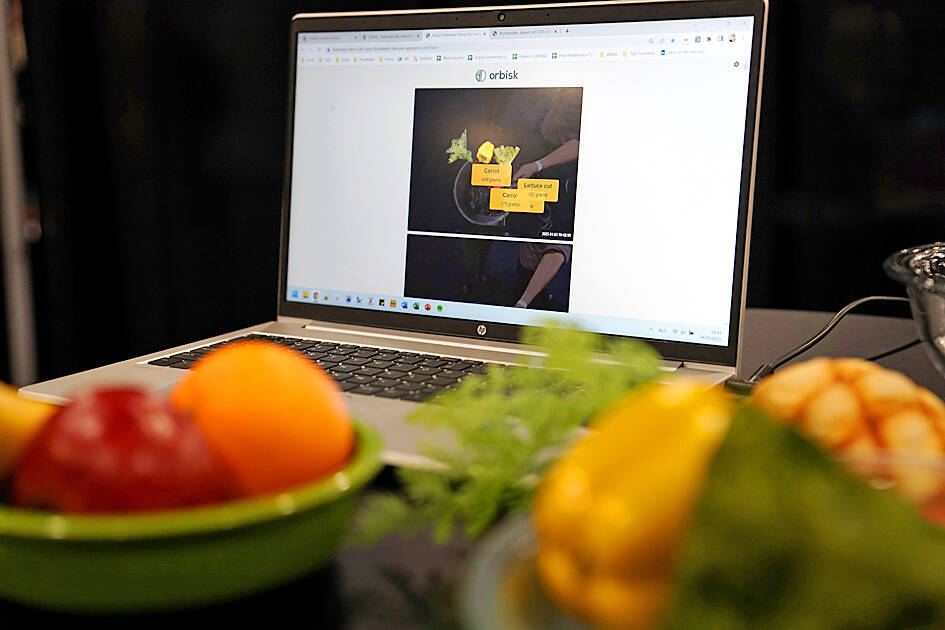Avocados can be tricky. Their ripeness window is so narrow that a slew of memes poke fun at the fine art of deciding when to eat them.
Dutch entrepreneur Marco Snikkers aims to solve that problem with an avocado scanner unveiled this week at the Consumer Electronics Show (CES) in Las Vegas, Nevada, and designed for use in supermarkets.
It uses optical sensing and artificial intelligence technology to determine ripeness, displaying on a screen whether an avocado is firm or ready to eat.

Photo: AP
Snikkers’ start-up, OneThird, is not just trying to reduce frustration in the kitchen.
According to the UN, about one-third of food is wasted globally.
That means all the carbon emitted to grow, ship and distribute that food was for naught.

Photo: AFP
“That’s a huge problem,” Snikkers said. “That’s a trillion dollar issue for our world, and it has a huge impact on C02 emissions and water usage.”
OneThird is one of several start-ups at this year’s CES working to solve different components of the problem, from helping the food industry limit what it throws away to offering rapid composting solutions to help keep food scraps out of methane-producing landfills.
OneThird says it already works with growers, distributors and others along the supply chain to predict the shelf life of avocados, tomatoes, strawberries and blueberries.
It plans to expand its ability to determine ripeness for more produce later this year, aiming to help reduce the amount of food that is wasted around the world.
It is testing the consumer-friendly avocado scanner at a supermarket in Canada this month.
Another Dutch entrepreneur, Olaf van der Veen, is working to empower restaurants to reduce food waste, the majority of which happens in a kitchen before a meal is even served to customers.
His device, Orbisk, uses a camera positioned over a trash bin to scan whatever food is about to be tossed.
In addition to seeing the type of food, amount and time of day, “we can see if it’s on a plate, in a pan, on a cutting board, which gives circumstantial information on why it was lost,” Van der Veen said.
Orbisk organizes and shares that insight with the restaurant so they can understand their disposal patterns, helping them save money and reduce food waste, and with it, emissions and water use, he said.
The start-up’s devices are positioned in commercial kitchens in about 10 European countries, with some clients as far as India.
He said that even after some surplus food is donated, there is more food waste per restaurant in the US than in Europe.
That is why the company is at CES, hoping to expand its nascent market further, he added.
Reducing the amount of wasted food is preferable, but keeping tossed food out of landfills is the next best option.
When food scraps are properly composted, they release carbon dioxide as part of the biological process of turning into nutrient-rich soil.
When food is trapped in landfills, the decomposition process produces methane — a potent greenhouse gas that contributes significantly to global warming because it packs a stronger short-term punch more than 80 times stronger than even carbon dioxide.
The 2006 London Protocol banned dumping food waste into the ocean, prompting South Korea to set up a system of mandatory composting.
While the infrastructure allows the country to properly dispose of nearly all its food waste, residents have to haul bags of food to designated curbside bins.
Reencle is designed to make that process easier.
The metal bin is a fast composting system showcased at CES this year, and helps households reduce 1kg of food scraps by 90 percent volume in just 24 hours, the company says.
While the product has sold tens of thousands of units in South Korea, Reencle’s parent company Hanmi Flexible hopes to expand to overseas markets, marketing director Jinhwi Bang said.
The device uses self-replicating microorganisms to turn scraps into compost.
Its competitor, Lomi, grinds and dehydrates food scraps, requiring the byproduct to be mixed with soil before composting, whereas Reencle says its byproduct can be composted directly.
Mark Murray, executive director of Californians Against Waste, said he hopes people do not think advanced technology is needed to be able to compost.
He said he understands that not everyone has a yard or a patio, and that “all of the tools in the toolbox have to be on the table.”
Technology is part of the solution, but economic incentives and systemic change are the other key components to reducing global food waste, he said.
“We need to make it more expensive to waste food,” he said. “That’ll create the incentive for commercial enterprises, for restaurants, for stores, for even consumers to invest in systems and technology for making sure that we don’t waste food.”

The US dollar was trading at NT$29.7 at 10am today on the Taipei Foreign Exchange, as the New Taiwan dollar gained NT$1.364 from the previous close last week. The NT dollar continued to rise today, after surging 3.07 percent on Friday. After opening at NT$30.91, the NT dollar gained more than NT$1 in just 15 minutes, briefly passing the NT$30 mark. Before the US Department of the Treasury's semi-annual currency report came out, expectations that the NT dollar would keep rising were already building. The NT dollar on Friday closed at NT$31.064, up by NT$0.953 — a 3.07 percent single-day gain. Today,

‘SHORT TERM’: The local currency would likely remain strong in the near term, driven by anticipated US trade pressure, capital inflows and expectations of a US Fed rate cut The US dollar is expected to fall below NT$30 in the near term, as traders anticipate increased pressure from Washington for Taiwan to allow the New Taiwan dollar to appreciate, Cathay United Bank (國泰世華銀行) chief economist Lin Chi-chao (林啟超) said. Following a sharp drop in the greenback against the NT dollar on Friday, Lin told the Central News Agency that the local currency is likely to remain strong in the short term, driven in part by market psychology surrounding anticipated US policy pressure. On Friday, the US dollar fell NT$0.953, or 3.07 percent, closing at NT$31.064 — its lowest level since Jan.

The New Taiwan dollar and Taiwanese stocks surged on signs that trade tensions between the world’s top two economies might start easing and as US tech earnings boosted the outlook of the nation’s semiconductor exports. The NT dollar strengthened as much as 3.8 percent versus the US dollar to 30.815, the biggest intraday gain since January 2011, closing at NT$31.064. The benchmark TAIEX jumped 2.73 percent to outperform the region’s equity gauges. Outlook for global trade improved after China said it is assessing possible trade talks with the US, providing a boost for the nation’s currency and shares. As the NT dollar

The Financial Supervisory Commission (FSC) yesterday met with some of the nation’s largest insurance companies as a skyrocketing New Taiwan dollar piles pressure on their hundreds of billions of dollars in US bond investments. The commission has asked some life insurance firms, among the biggest Asian holders of US debt, to discuss how the rapidly strengthening NT dollar has impacted their operations, people familiar with the matter said. The meeting took place as the NT dollar jumped as much as 5 percent yesterday, its biggest intraday gain in more than three decades. The local currency surged as exporters rushed to